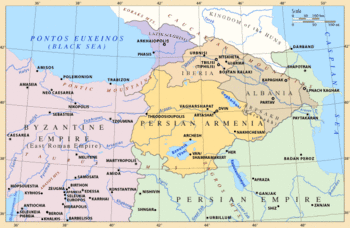Sasanian Armenia facts for kids
Quick facts for kids
Sasanian Armenia
|
|||||||||
|---|---|---|---|---|---|---|---|---|---|
| 252 – 299 387-428 428–646 |
|||||||||

Sasanian Armenia ca. 387-591
|
|||||||||
| Status | Province of the Sasanian Empire | ||||||||
| Capital | Dvin | ||||||||
| Common languages |
|
||||||||
| Religion | Armenian Apostolic Zoroastrianism |
||||||||
| Government | Monarchy | ||||||||
| Historical era | Middle Ages | ||||||||
|
• Established
|
252/3 | ||||||||
|
• Romano-Armenian conquest
|
299 | ||||||||
|
• Partition of Armenia
|
387 | ||||||||
|
• Marzbanate period starts
|
428 | ||||||||
|
• Rashidun conquest
|
646 | ||||||||
|
|||||||||
Sasanian Armenia, also known as Persian Armenia, refers to a time when Armenia was under the control of the Sasanian Empire of Persia. This period lasted for several centuries. Sometimes, the name refers specifically to the parts of Armenia that Persia ruled.
For example, in 387 AD, Armenia was divided. Parts of western Armenia became part of the Byzantine Empire. The rest of Armenia came under Sasanian control. Even then, Armenia kept its own kingdom until 428 AD.
In 428 AD, Armenian nobles asked the Sasanian king, Bahram V, to remove their own king, Artaxias IV. King Bahram V then ended the Armenian Kingdom. He appointed a special governor called a marzban to rule the country. This started a new time known as the Marzpanate period. During this period, marzbans (governors chosen by the Sasanian emperor) ruled eastern Armenia. Western Armenia, called Byzantine Armenia, was ruled by different princes and governors under Byzantine control. The Marzpanate period ended in the 7th century when the Arab conquest of Armenia happened. After this, the Principality of Armenia was formed. About three million Armenians lived under the rule of the Sasanian marzbans during this time.
Contents
How Sasanian Armenia Was Governed
The marzban was a very powerful governor. He could even order death sentences. However, he could not change the old rights and special powers of the Armenian nobles, called nakharars. Overall, the country had a good amount of freedom to govern itself.
Key Roles in Government
- The Hazarapet was like a Minister of the Interior. This person was in charge of public works and money matters. This important job was usually given to an Armenian.
- The Sparapet was the commander-in-chief of the army. This role was always given to an Armenian.
- Each nakharar (Armenian noble) had his own army. The size of the army depended on how much land he owned.
- The "National Cavalry" or "Royal force" was under the main commander-in-chief.
- All the tax collectors were Armenians.
- Armenian church leaders ran the courts and schools.
Sometimes, an Armenian nakharar even became the Marzpan. For example, Vahan Mamikonian became Marzpan in 485 AD after a time of rebellion against the Iranians.
Religion and Culture Under Sasanian Rule
During the Marzpanate period, the Iranian kings tried three times to stop Christianity in Armenia. The Iranians had allowed Armenians to create their own Armenian alphabet and build schools. They thought this would make Armenians feel more separate from the Byzantines. However, the new Armenian culture actually led to closer ties with Byzantium.
Images for kids
See also
 In Spanish: Armenia persa para niños
In Spanish: Armenia persa para niños



